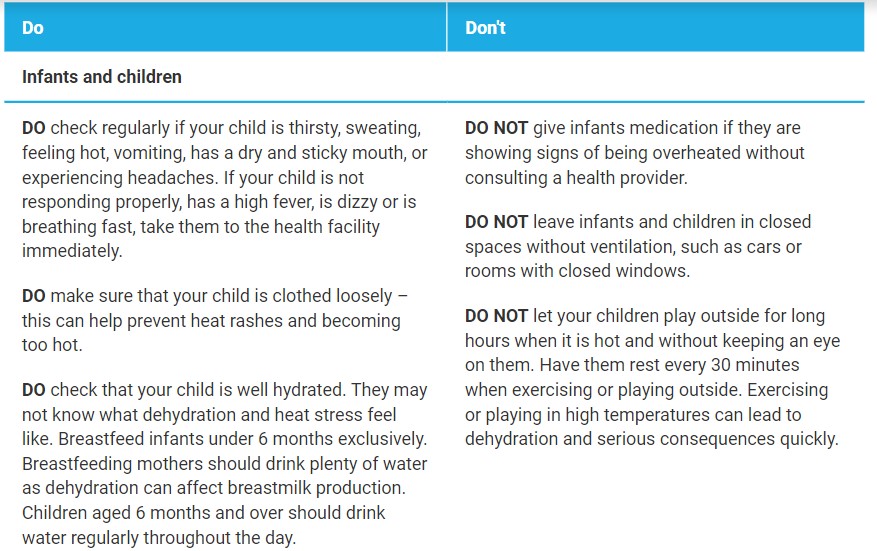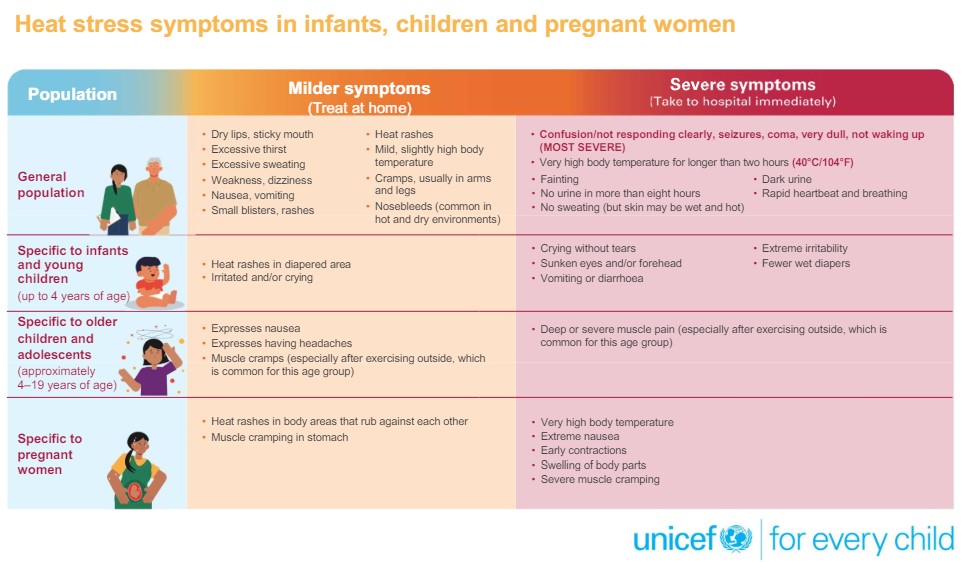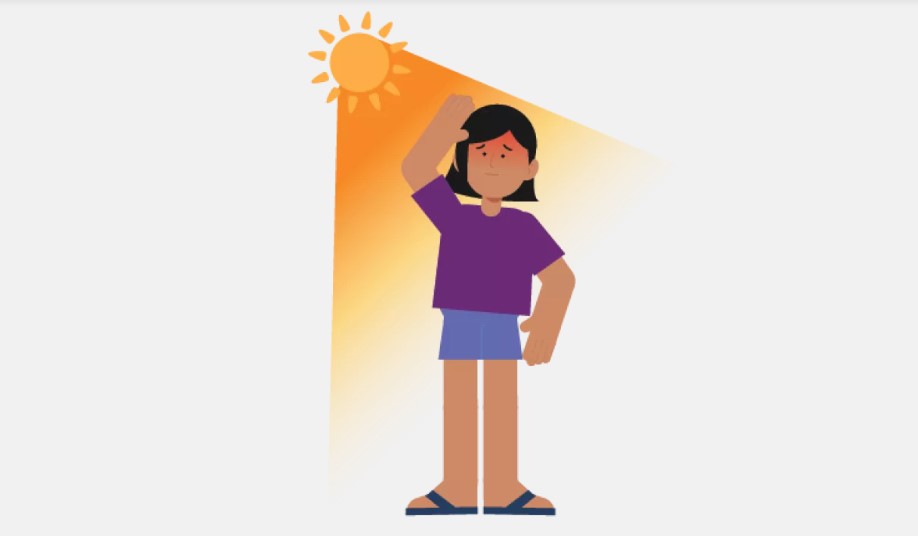Learn how to help keep your children and family safe in extreme heat.
Heat waves are anything but fun in the sun.
Extreme heat and humidity can be extremely uncomfortable and pose serious health risks, especially for infants, children, pregnant women and the elderly.
Without taking the proper precautions, extreme heat can lead to heat stroke and even worse, fatality. As a result of climate change, heat waves are becoming longer, more frequent and more severe.
Here are some expert tips to help keep your family safe during a heat wave, how to recognize signs of heat stroke and what actions you should take if needed.
What is a heat wave?
Heat waves happen when the temperature is higher than normal for several days in a row. Humidity can cause it to feel much hotter.
What causes a heat wave?
Heat waves result from warm air being trapped in the atmosphere and are a natural weather phenomenon. Heat waves are increasing in intensity and frequency due to climate change, resulting from greenhouse gas emissions, that is trapping heat for longer.
Who’s most at risk from heat waves?
Too much heat is dangerous for everyone’s health. Infants, children, pregnant women and the elderly are especially vulnerable to heat stress.
Too much heat can be more dangerous for babies and children than for adults, and dehydration in children can be dangerous or even deadly. Children’s bodies have more trouble regulating temperature than those of adults, and they rely on adults to help protect them from heat.
Pregnant women are at greater risk as well. Too much heat and dehydration can put the baby at higher risk of low birthweight, early birth and even stillbirth. Pregnant women themselves can be negatively affected and go into early labour, as well as develop gestational diabetes and hypertension.
What to do in a heat wave
Be prepared
- Know how hot and humid it is going to get today, this week and this month to help plan outside activities.
- Keep an emergency kit at home that contains oral rehydration salt (ORS) packets, a thermometer, water bottles, towels or cloths to wet for cooling, a handheld fan or mister with batteries, and a checklist to identify and treat symptoms of heat stress.
- Know how to get help.
- Note down the contact information for the nearest health care provider or ambulance/transport services.
Keep your home cool
- When possible, close the curtains during the hottest parts of the day and open windows at night time to cool down the house.
- Use fans and coolers if available.
Stay out of the heat
- Do not go outside during the hottest times of the day if you can avoid it. Try to arrange your activities earlier or later in the day when it is cooler.
- When outside, wear sunscreen and try to stay in the shade or use hats and umbrellas for protection.
Stay cool and hydrated
- Drink water at regular intervals before you are thirsty.
- Overdressing in the heat can make you dehydrated and hotter faster, so wear light and loose clothes. Cotton is ideal during hot days to help reduce heat rashes and absorb sweating. Similarly, cotton bed sheets are recommended over non-breathable materials.
- Carry a water bottle and a small towel, so you can hydrate and cool down by placing a wet towel on your neck.
- Check to see if your community has a heat relief or cooling centre near you. You could also use the waiting areas of health facilities as a temporary cooling shelter.
Tips for infants, children and pregnant women


Signs and symptoms of heat-related illness

How to treat heatstroke and heat-related illnesses
Take the following steps to help your loved one cool, rehydrate and recover:
Cool and rush to health facility if severe
If a family member is experiencing severe symptoms of heat-related illnesses, it is important to cool first and transport second.
Help the person sit or lie down in a cool shaded area with good ventilation. Close curtains to create more shade. Turn on a fan or air conditioner if available. Apply wet towels to the skin at head, neck, armpits and groin.
Infants and children: Remove outer layers of clothing.
Pregnant women: Have them remove excess layers of clothing in a private area if possible. Have them sleep on their left side or leaning to the left.
If the person is unconscious or vomiting, lay them on their side until transport to the health facility arrives.
If no severe symptoms then treat at home and continue to Step 2: Reduce temperature.
Reduce temperature
Move the person into a cool area if not done so already. Close curtains to create more shade. Turn on a fan or air conditioner if available.
Apply wet towels or cool water to the body, particularly at head, neck, armpits and groin. Keep changing the towels or dipping them in cool water every few minutes to provide cool water for the body.
If available, use a fan and a misting spray to spray lukewarm water onto the body and dry it off with the fan running at the same time. Place ice or a wet towel on the neck, armpits or groin with the fan running as well. Help fan the body manually if no fan is available.
Hands and feet can be put into containers of cool water to help cool off the body faster. Older children and adults can be immersed into cool (but NOT ice cold) water if available, or a cold shower.
DO NOT immerse infants and young children into very cold water.
DO NOT point the fan at the face, especially infants.
DO NOT give paracetamol/acetaminophen without advice from your health provider.
Continue to Step 3: Rehydrate.
Rehydrate
Infants under six months: Breastfeed to rehydrate the infant. Encourage mother to also drink more water, especially if breastfeeding.
Older infants and children: Given your infant or child water in small amounts to help them become used to it.
If the child has sweated a lot or is sweating a lot, add some Oral Rehydration Salt (ORS) to the water for the child. Carefully follow the directions on the packet. If there are no directions, use the following guidance:
A child under the age of two years needs at least 1/4 to 1/2 of a large (250 ml) cup of the ORS drink
A child aged two years or older needs at least 1/2 to 1 whole large (250 ml) cup of the ORS drink
If no premade ORS is available dissolve six level teaspoons of sugar and 1/2 level teaspoon of salt in 1 litre of clean water.
Older children and pregnant women: Add ORS to water if excessively sweating. They should drink 100 ml of ORS every 5 minutes until they seem better.









Comment